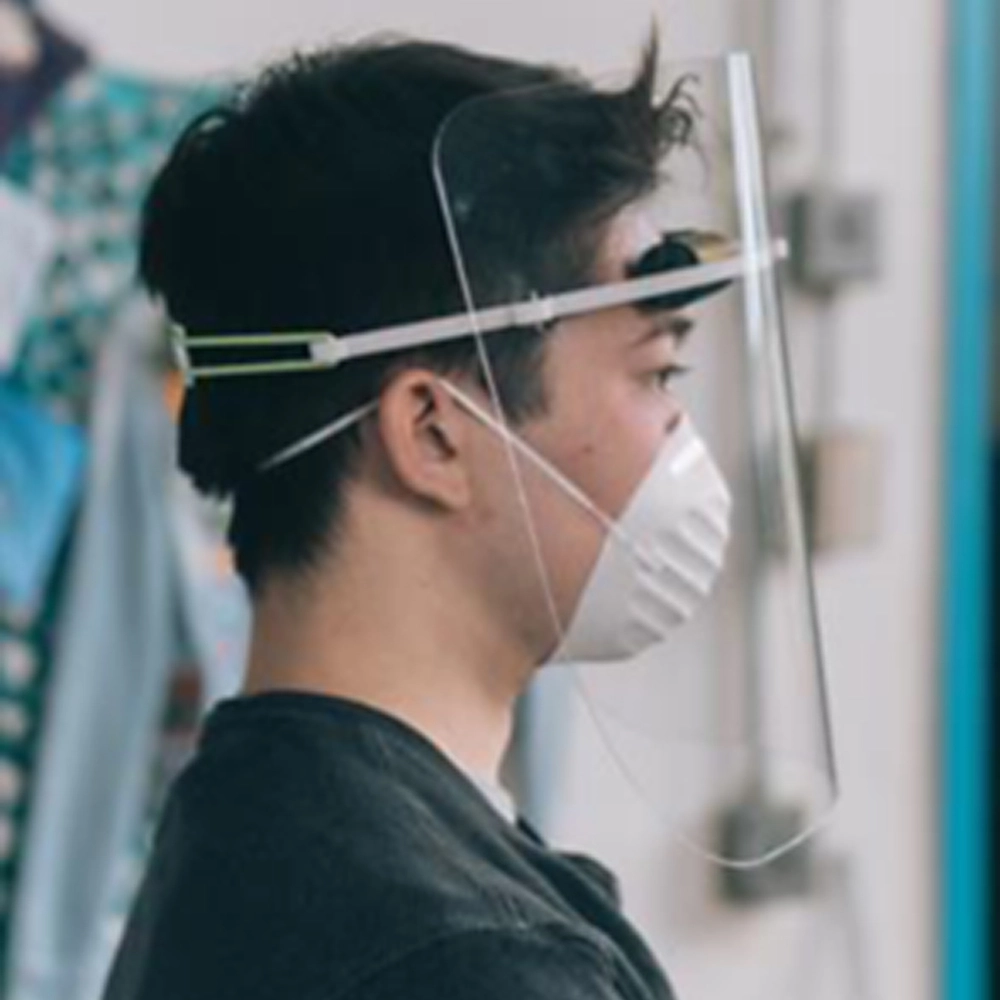
Whether designing and producing face shields for healthcare workers, creating components for virus test kits, developing more accurate widely-deployable testing methods to better detect COVID-19 or stopping the virus from ever entering human cells, researchers in the Department of Chemistry have mobilized quickly during this pandemic to apply their expertise to this healthcare crisis in a variety of ways.
Early on, Martin D. Burke, the May and Ving Lee Professor for Chemical Innovation and Professor of Chemistry, was involved with a team of engineers, physicians, researchers and designers from the university and from Carle Health who developed and launched production of a face shield for health professionals responding to the COVID-19 pandemic. Burke is also involved with multiple COVID-19 research projects, including providing amphotericin for diagnostics and a project with Professor Emad Tajkhorshid studing COVID-19 spike protein-building peptides.
Similar collaboration with other researchers across campus and at other institutions has led to a variety of other projects involving Chemistry at Illinois faculty members, including Jeff Moore and Doug Mitchell, who are creating liquid and swab components for COVID-19 test kits; Paul Hergenrother, who is screening small molecules for COVID-19 spike protein binding; Xing Wang who is developing novel COVID-19 diagnostics; Yi Lu, who is developing more accurate diagnostic virus testing methods; and Wilfred van der Donk, who is researching compounds that could stop the virus from entering human cells altogether.
Here are more details about three of these COVID-19 projects:
- Yi Lu, the Jay and Ann Schenck Professor of Chemistry, received a National Science Foundation grant for a COVID-19 project with Lijun Rong, a professor in the Department of Microbiology and Immunology at the University of Illinois at Chicago. The researchers were recently awarded a $154,457 RAPID grant from NSF to develop a new widely-deployable method to more efficiently detect COVID-19.
The goal is to identify and synthesize DNA aptamers — short, single-stranded DNA molecules that can selectively bind to a target. The aptamers will bind the intact infectious SARS-CoV-2, the virus that causes COVID-19, but not the non-infectious forms or other viruses and interfering species, with high specificity and affinity, Lu explained.
When the DNA is immobilized into a nanopore, a tiny pore of nanometer size, this method would be less resource intensive than the sensing technique commonly used now, he said, and it would also simplify the testing procedure partly because sample pretreatment would not be needed. And it would also minimize the chance of cross contamination.
“Most importantly, our method addresses a major limitation of current COVID-19 diagnostic tests that are mostly based on detecting viral RNA; they cannot inform whether the virus is infectious or not,” Lu said, “because it has been shown that the presence of viral RNA in specimens does not always correlate with viral transmissibility”
He emphasized the importance of rapid and accurate detection of the infectious viruses. It provides patients the opportunity to receive proper treatments early on and prevents them from unknowingly spreading the infectious virus to others, Lu explained, and it also eliminates unnecessary quarantine of non-contagious patients and enables assessment of whether surfaces at critical locations, such as hospitals, airports, grocery stores and home, have been properly disinfected. Lu is one of three Nick Holonyak Jr., Micro and Nanotechnology Lab (HMNTL) faculty members that have received RAPID grants, all of which hope to shorten the amount of time it takes to process a COVID-19 test.
-
Wilfred van der Donk is doing research to stop the virus from entering human cells, which would prevent the virus infection.
Van der Donk, the Richard E. Heckert Endowed Chair in Chemistry, Director of Graduate Studies and Howard Hughes Medical Institute Investigator, explained how the SARS-CoV-2 virus that causes COVID-19 enters human cells by recognition of a surface receptor called the human acetyl choline esterase 2 (ACE2).
“The SARS-CoV-2 spike protein, so called because it is the protein that is responsible for the ‘spiky’ protrusions that are shown in artistic renditions of the virus, binds to ACE2 in the first step of entry into human cells,” he said. “If this entry can be stopped, virus infection will be prevented.
The molecular structure of the spike protein bound to ACE2 is known, van der Donk said, and the laboratory of Erik Procko in the Department of Biochemistry at Illinois has studied this interaction.
Compounds that mimic the part of the ACE2 protein where the spike protein binds could in principle work as decoys that bind to the virus and prevent it from interacting with ACE2, and that approach to fighting COVID-19 is what the van der Donk and Procko laboratories are exploring together.
“We use so-called lanthipeptides that resemble the part of ACE2 where the spike protein binds,” van der Donk explained. “Lanthipeptides are very stable compounds made in nature and are already used in the food industry to kill food-borne pathogens.”
-
The face shield project that Burke, an Associate Dean for Research at Carle Illinois College of Medicine, helped lead was part of a larger Personal Protective Equipment (PPE) design initiative led jointly by The Grainger College of Engineering and the Carle Illinois College of Medicine’s Health Maker Lab.

“The goal of the PPE initiative is to leverage the collective power of the Health Maker Lab to respond to the urgent need to help front-line healthcare workers,” Burke said. “Barrier-less collaboration between experts in medical sciences, engineering and design, in partnership with physicians, nurses and community members, has enabled extraordinary innovation in a time of crisis.”
The face shields initiative is beyond the development phase now as Carle healthcare workers in Champaign County beta tested a small batch of prototypes. The university's goal was to produce at least 2,000 face shields to support short-term needs, then partner with local manufacturers like ShapeMaster, Inc., Wagner Machine Co. and others, and seek grants for them to produce the face shields on a larger scale, according to Lisa Bievenue, director of Informatics Program and of the CU Community Fab Lab.
The team is also collaborating to design and test prototypes for other PPE products as well as sterilization technologies, including N95 respirators, disposable and reusable gowns, masks and caps, and mid- and small-scale sterilization technologies, according to Helen Nguyen, professor in the Department of Civil and Environmental Engineering who helped lead the project. “Dozens of professionals, from engineers, physicians and researchers to costume designers, staff and students, and community members are contributing their expertise and talents on these projects,” Nguyen said.